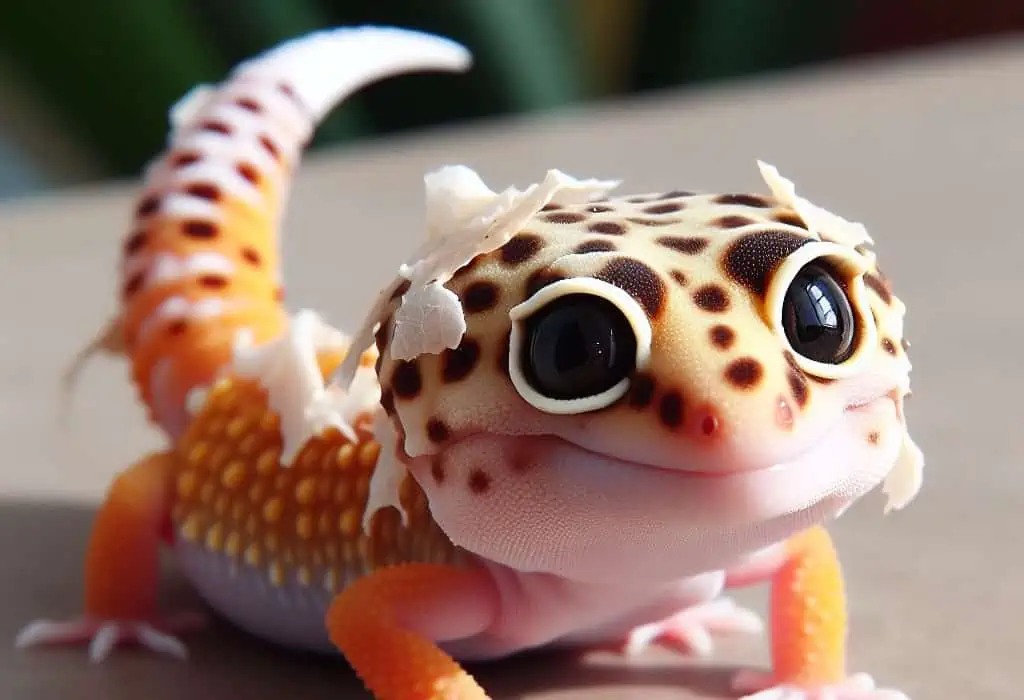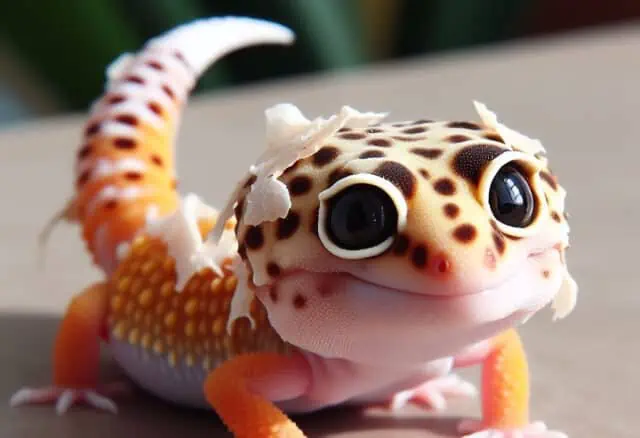Leopard Geckos, like many of their reptilian cousins, undergo a natural shedding process. This is when they cast off their old skin to reveal a fresh, new layer underneath. However, sometimes, things don’t go according to plan. Due to various factors, a leopard gecko’s shed might stubbornly cling to their head. This isn’t just a minor inconvenience; it can be a genuine concern for their health and well-being.
This phenomenon, known to herpetologists as “dysecdysis,” happens when conditions aren’t optimal for the shedding process. The reasons can range from environmental factors, dietary insufficiencies, or even age-related changes.
Proper Humidity is Essential: Ensure your leopard gecko’s enclosure maintains a humidity level of 40% to 60%. This range helps facilitate smoother shedding.
Create a Moist Hide: Place a warm and moist hide—filled with damp moss or paper towels—on the warm side of the enclosure. It provides the moisture needed for efficient shedding.
Balanced Diet Matters: Feed your gecko a varied diet of insects dusted with essential vitamins and minerals, particularly calcium and vitamin D3.
Monitor Regularly: Keep a close eye on your gecko during its shedding phase to spot and address any stuck shed issues early.
Act with Caution: If a shed is stuck on your gecko’s head, consider gentle methods like soaking in lukewarm water. Avoid interfering unless absolutely necessary.
Leopard Gecko Shed Stuck On Head: How You Can Help
Leopard geckos, by nature, undergo the fascinating process of shedding. However, there are instances when this process doesn’t proceed smoothly, and shed gets trapped, especially around their head. So, how can you lend a helping hand without causing any harm?
First and foremost, it’s essential to understand the significance of not interfering with the shedding process unless it’s absolutely necessary. Leopard geckos have been shedding their skin long before they became popular pets, and their bodies are well-equipped to handle this process naturally. In most cases, they’ll find their way out of the old skin without any external help. However, when the shed becomes persistently stuck, particularly around sensitive areas like the head, it might be time for you to intervene.
If you do decide to step in, always choose gentle methods. Remember, their skin is delicate, and any harsh action could lead to injuries. One recommended approach is to soak your gecko in lukewarm water for a brief period. This soaking can help soften the stuck shed, making it easier for the gecko to remove it. Another option is to gently dab a damp towel on the problematic area, moistening the stuck shed. This technique provides added moisture, facilitating the natural shedding process.
While aiding your gecko during a problematic shed is commendable, preventing such instances is even more crucial. Here are some proactive measures to ensure a smoother shedding experience for your pet:
Moist Hide: Providing a moist hide is essential. This humid environment facilitates the shedding process, ensuring the old skin comes off more easily.
Proper Nutrition: Just like how our skin health is influenced by our diet, a leopard gecko’s shedding process is also impacted by its nutrition. Ensure your gecko receives a balanced diet, rich in essential vitamins and minerals. Proper nutrition not only aids in the shedding process but also ensures overall health and vitality.
What Causes Shedding Problems in Leopard Geckos?
Shedding is a natural process for leopard geckos, yet sometimes, issues arise that make this process less than straightforward. Understanding the underlying causes of these shedding problems is essential for ensuring your gecko’s well-being.
At the heart of most shedding problems in leopard geckos is a condition known as dysecdysis. Dysecdysis refers to abnormal or problematic shedding, where the gecko struggles to fully remove its old skin. While many factors can lead to dysecdysis, certain triggers are more common than others.
Age is one of the contributing factors to shedding problems. Younger geckos, being less experienced, might sometimes struggle with their first few sheds. As they mature, the shedding process generally becomes smoother. However, older geckos can also face difficulties, often due to decreased mobility or underlying health issues.
Diet plays a pivotal role in a gecko’s health, and this extends to its shedding process. A malnourished gecko may have a weakened system, leading to irregularities during shedding. Ensuring your gecko receives a balanced diet with all the necessary vitamins and minerals is crucial. Not only does it bolster their overall health, but it also fortifies their skin, making the shedding process more efficient.
Lastly, a gecko’s habitat can make or break the shedding process. The environment they reside in should mimic their natural habitat as closely as possible. Essential factors include the right level of humidity, proper heating, and appropriate substrates.
A habitat that’s too dry can result in the skin becoming less elastic and harder to shed, leading to stuck shed. Conversely, an overly damp habitat can introduce other health problems.
Symptoms of a Stuck Shed on Your Leopard Gecko’s Head
One of the primary concerns for many leopard gecko owners is ensuring their pet’s shedding process goes smoothly. While the shedding process generally transpires without complications, at times, problems arise—especially around the gecko’s head. Recognizing the signs of a stuck shed early can make all the difference in providing prompt care and ensuring the gecko’s well-being.
Thick Shed Around Mouth and Chin
One of the most telling signs of a stuck shed on a leopard gecko is the presence of a thick shed around the mouth and chin area. This build-up can look uneven and layered, differing starkly from the smooth appearance of a regular shed. If not addressed promptly, this accumulation can make it challenging for the gecko to eat or even open its mouth properly.
Raw and Exposed Skin
In trying to remove the stubborn shed, a gecko might accidentally harm itself, leading to raw skin. This exposed skin can be sensitive, more susceptible to infections, and generally uncomfortable for the reptile. The skin might appear redder than usual, and you might notice your gecko being more agitated when this area is touched.
Difficulty Closing the Mouth
Another alarming symptom is when your gecko struggles to close its mouth entirely. This can be due to the thick layers of shed inhibiting its natural movement. Over time, this can become a serious concern, particularly if it interferes with their eating habits.
Poor Coordination and Signs of Pain
If the stuck shed persists, you might notice your leopard gecko exhibiting signs of poor coordination, especially around the head area. This can manifest in the form of unsteady movements, a tilted head, or even difficulty capturing prey. Additionally, your gecko might exhibit signs of pain, such as restlessness, reduced appetite, or an aversion to being touched around the head.
How to Prevent a Stuck Shed on Your Leopard Gecko’s Head
For every leopard gecko owner, seeing their pet struggle with a stuck shed can be distressing. Fortunately, with a bit of knowledge and proactive care, preventing a stuck shed—particularly on the gecko’s head—is entirely achievable. Here are steps you can take to ensure your leopard gecko enjoys a hassle-free shedding process.
The significance of proper humidity levels in your gecko’s enclosure can’t be overstated. Leopard geckos thrive in environments that closely mimic their natural habitats, which means maintaining a humidity level of around 40% to 60%. This optimal range facilitates smoother shedding. It’s essential to invest in a good hygrometer to monitor the enclosure’s humidity levels. If you find the humidity dropping below the ideal range, consider misting the enclosure or using a humidifier.
A warm and moist hide acts as a sanctuary for your gecko during its shedding phase. This hide provides a conducive environment for shedding, offering the moisture needed to loosen the old skin. You can easily create a moist hide using a plastic container filled with damp moss or paper towels. Place this hide on the warm side of the enclosure to ensure it remains at the right temperature and moisture levels.
A balanced diet is the cornerstone of your gecko’s overall health and, by extension, its shedding process. Ensure that your gecko’s diet is rich in essential vitamins and minerals, especially calcium and vitamin D3. Feed them a variety of insects, including crickets, mealworms, and dubia roaches, dusted with a quality reptile vitamin and mineral supplement. A well-fed gecko is more likely to shed its skin efficiently and without complications.
Lastly, always keep an eye on your gecko, especially during its shedding phase. Regular monitoring allows you to spot any potential stuck shed issues on your leopard gecko’s head early on. If you notice any anomalies, it’s easier to intervene promptly and prevent any complications.






